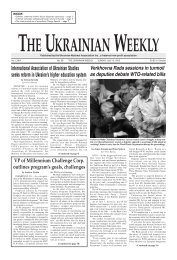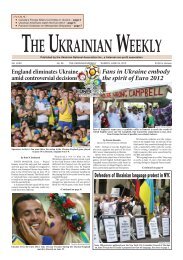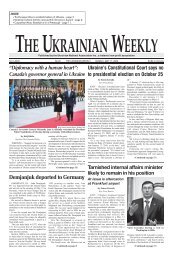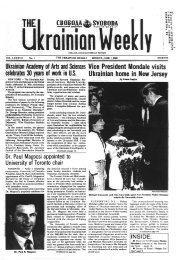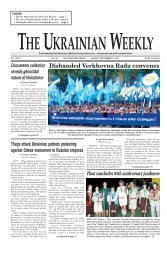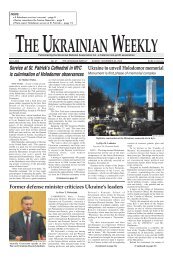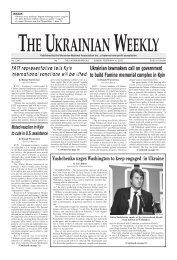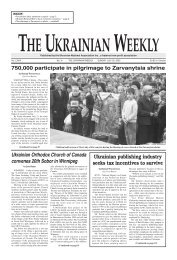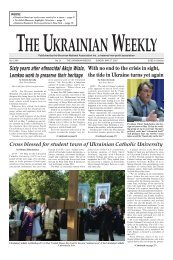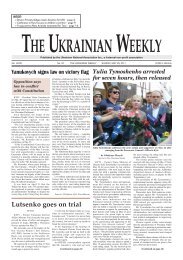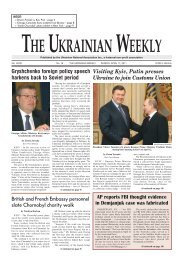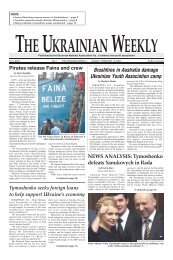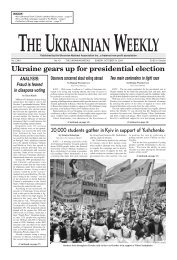THE UKRAINIAN WEEKLY SUNDAY, DECEMBER 5,<strong>1993</strong> No. 49<strong>The</strong> demand for Ukraine's most precious resource — its childrenTemopil updateby Khristina LewEducation Center in Lviv establish tieswith the <strong>Ukrainian</strong> Saturday schools theTemopil orphans attend in the UnitedStates in order to provide any necessaryaid and maintain contacts. <strong>The</strong> directivealso instructed the education minister toOn August 9-24, a special commissionappointed by Ukraine's Minister forHumanitarian Affairs Mykola Zhulynsky inform all local education authoritiestraveled to the United States to review that in the future no collective departuresthe case of the 54 "orphans'' from of children beyond Ukraine's borders forTemopil.foreign adoption will be permitted.<strong>The</strong> four-member parliamentary-governmentWith the government intervening oncommission, comprising behalf of a swift resolution to the thenPeople's Deputies Iryna Kalynets and 18-month-old case, prospects for the dis-Kateryna Zavadska, and Cabinet ofMinisters attorneys LiudmilaVynohradovna and Larisa Artamovnova,met with the families and children inquestion, reviewed the myriad adoptiondocuments on the basis of existing<strong>Ukrainian</strong> laws, and determined, case bycase, whether the adoption was in thebest interest of the child.Based on the commission's recommendations,on September 17 MinisterZhulynsky issued three directives. <strong>The</strong>first notified the head of the TemopilOblast Government Administration,Roman Hromiak, that, as an exception,the minister had given his permission to patch of the 54 adoptions by theformulate adoption documents for th^ 54 November 1 deadline appeared certain.children in question without their return But when Pastor Darald Gruen andto Ukraine. (While the adoption of a Mykola Semeniak of the Ternopil<strong>Ukrainian</strong> child by foreigners is Orphans' Adopting Parents Committeeprocessed on the raion level, permission traveled to Ukraine in mid-October toto adopt is granted by the oblast governmentrepresent 43 of the Ternopil orphansadministration.)before the raion commissions, they met<strong>The</strong> second directed Ukraine's with stiff opposition.Ministry of Foreign Affairs to prepare a This is the fifth in a series of articlesletter to the U.S. government explaining about the demand for Ukraine's mostUkraine's law on an adopted child's precious resource — its children.<strong>Ukrainian</strong> citizenship until the age of 18,at which point the child may choose his JERSEY CITY, N J. — In less thanor her citizenship. Minister Zhulynsky two months, on January 28, 1994, the 54also requested that Chicago's Consul orphans from Ternopil will have residedGeneral Anatoliy Oliynyk be instructedto issue the children new passports oncein the United States for two years. <strong>The</strong>U.S. Immigration and Nationality Act dictatesthe adoptions were processed andthat the non-immigrant status of theapproved in Ukraine. (At the time <strong>The</strong> Ternopil orphans can change to lawful<strong>Ukrainian</strong> <strong>Weekly</strong> was going to print. permanent resident status in two instances:Consul Oliynyk was unavailable for comment.)if the child is adopted before the age of 16or if the child has been in the legal custody<strong>The</strong> third directive, addressed toof, and resided with, the adoptingUkraine's Ministry of Education, parent or parents for at least two years.requested that the International Although the parliamentary-govern-ment commission's August visit to theU.S. was an attempt to determinewhether each adoption was in the bestinterest of the child, prior to oblastapproval, each case had to be reviewedby one of four raion commissions inTernopil. Pastor Darald Gruen andMykola Semeniak of the TernopilOrphans' Adopting Parents Committeewere appointed to legally represent 43children before the raion commissions;the remaining 11 are represented byChicago attorney Roxolanna Harasymiw.In Ternopil, as in earlier times, politics haveintervened. <strong>The</strong> <strong>Ukrainian</strong> ConservativeRepublican Party and the raion commissionsrefuse to comply with the adoptions.— Roman HromiakTernopil Oblast GovernmentAdministration headPastor Gruen reports that during hisjourney 16 of the 43 children wereapproved totally or with one condition foradoption. He relays that the Monastyrskaraion overwhelmingly approved the adoptionof numerous children, only to withdrawthat approval after the orphanagedirector there refused to comply.Ms. Harasymiw, who was en route toUkraine on December 2, said she had had"some luck" with getting adoptionsapproved.Roman Hromiak, the man with the finalsay on the adoptions as the head of theTernopil Oblast GovernmentAdministration, explains that in Ternopil,"as in earlier times, politics have intervened.<strong>The</strong> <strong>Ukrainian</strong> ConservativeRepublican Party and the raion commissionsrefuse to comply with the adoptions."According to Mr. Hromiak, the greatestopponent to the adoptions is the head ofthe Ternopil City Administration,Vyacheslav Nehoda, who insists that thechildren return to Ukraine despite MinisterZhulynsky's directive allowing them toremain in the U.S. Ternopil City CouncilDeputy Romania Kozemchuk told a localTernopil newspaper in October that "inthe first place, the children should bereturned to Ukraine, and then after, if theywant, let them choose their path." Mr.Hromiak, who is also the president's representativein Ternopil, explained thatsome political forces believe the childrenshould not be adopted at all, but that theyshould remain in Ukraine to bolster itsdwindling population.People's Deputies Iryna Kalynets andKateiyna Zavadska have been instrumentalis pushing for a speedy resolution tothe case. Ms. Zavadska, who took leaveof her duties in Kyyiv to assist PastorGruen during his trip to Ternopil, has, inthe words of Walter Goncharoff of theTernopil Orphans' Parents AdoptingCommittee, "put her career on the line. Ifit weren't for her," said Mr. Goncharoff,"we wouldn't have a chance."Mr. Hromiak echoes Mr. Goncharoff ssentiments, saying that the political partiesclamoring for the children's returnhave greatly criticized the efforts of thetwo people's deputies.Mr. Hromiak, who emphasized that thefuture well-being of the oфhans is at stake,is working with the government to find ameans to alleviate opposition, with smallresults. He has himself traveled to the raioncommissions with the documents legalizedby Consul General Anatoliy Oliynyk, onlyto be met with opposition. Hoping toresolve the issue by the end of the year,Mr. Hromiak has approved eight adoptionsand has requested that the paperwork forthose eight be delivered to Kyyiv for theissuance of immigrant passports.Despite the legal implications of theINS two-year waiting period — at whichpoint the adopting parents can adopt theTernopil oфhans in the U.S. court system— and the November I deadline that cameand went, the Temopil Oфhans' AdoptingParents Committee has agreed to patientlyawait the decision of the <strong>Ukrainian</strong> side inthis 20-month battle until the end of theyear. "We have assurances from governmentofficials that things are proceeding,"Pastor Gruen said. "We are leaving the situationin the hands of those officials."OBITUARY:Hanna KorenetS, Plast leader Odessa Philharmonic cited in pressCHICAGO — Hanna (Handzia)KorenetS, prominent leader andorganizer in the <strong>Ukrainian</strong> scoutingorganization Plast, died November6 in Chicago at the age of 86.Ms. KorenetS joined Plast at theage of 13 as a member of the MartaBoretska Troop No. 2 at theBasilian Sisters' Gymnasium inLviv. In 1927, she joined the Plastsorority "Ті Shcho Hrebli Rvut,"which she subsequently headed for50 years. Upon resigning her post,Ms. KorenetS was made honoraryhead of both the senior and adultscout female divisions and accordedthe title "Persha Hreblia."Ms. KorenetS was born in 1907in Lviv, the second of two daughtersof Denys and Olha, neeDobrianska.A pharmacist by profession, Ms.KorenetS, upon completion of herstudies at the university in Poznan,Poland, returned to Ukraine and setup her own pharmacy in Lviv.When Plast was banned byPolish authorities in 1930, Ms.KorenetS stayed in Plast's ranks asit was forced underground. Duringthe war, in 1942-1945, Ms.KorenetS was active in theAssociations for the Upbringing of<strong>Ukrainian</strong> Youth, in charge ofdeveloping general educationalguidelines.With the re-establishment ofPlast in Germany in 1945, Ms.KorenetS was elected to the leadershipof the Association of Emigre<strong>Ukrainian</strong> Plast Members, was amember of the Supreme PlastCommand of <strong>Ukrainian</strong> PlastMembers in Germany, 1947, and in1947-1949, she held the position ofdeputy-chief commandant ofHanna KorenetS in 1957.female Plast members.Upon emigrating to the UnitedStates and settling in Newark, N.J.,Ms. KorenetS continued her workin Plast as member of the SupremePlast Council, director of counselortraining, head of the committee onideology at the Second PlastCongress, and active member ofthe Newark Plast branch.For her committed work inPlast, Ms. KorenetS was awardedPlast's Gold Medal of St. Georgeand the Cross of Merit for WorthyDeeds.Apart from her life of dedicationto Plast, Ms. KorenetS was a memberof the <strong>Ukrainian</strong> NationalWomen's League of America andthe <strong>Ukrainian</strong> Patriarchal Society.Burial services were heldNovember 13 at St. Andrew theFirst-Called Apostle <strong>Ukrainian</strong>Orthodox Cemetery in SouthBound Brook, N.J.Ms. KorenetS is survived by hersister Marta Pryjma and hernephews Yuriy and Ihor. In observanceof the 40th day of Ms.Korenets' passing, Plast will hold acommemorative evening onDecember 18 in New York.SHORT HILLS, N.J. — <strong>The</strong> Odessa PhilharmonicOrchestra received very favorable reviews following itsAmerican debut in Chicago's Orchestra Hall on November19. Reviewer Dan Tucker of the Chicago Tribune wrotethat the orchestra "showed that it could join the top ranks ofAmerican orchestras without breaking steps. Its sound isbright and confident... and it is equally sure of itself performingProkofiev, Mahler or a composer from its homeground, Boris Liatoshynsky."Mr. Tucher dwelt at length on the virtues ofLiatoshynsky's Symphony No. 3, suggesting that theChicago performance "should create an appetite" for the<strong>Ukrainian</strong> composer's words. He also praised the orchestra'srendition of Prokofiev's "Romeo and Juliet," noting that theOdessa Philharmonic "showed off impressive solo playingfrom its first chair wind and string players."<strong>The</strong> Tribune attributed much of the orchestra's success toits young American conductor, Hobart Earle. "Aside fromhis obvious gifts as a conductor," said the reviewer, "Earleshows talent as a diplomat." <strong>The</strong> Tribune commented favorablyon Mr. Earle's success in promoting the orchestra andthe culture of Ukraine. In a separate article under the headline"Tour de Force," Tribune music critic John von Rheintraced the "perilous journey" that Mr. Earie took to organizethe Odessa Philharmonic's first American tour, citing thefinancial obstacles and bureaucratic hurdles the orchestrahad to overcome, both in Ukraine and in the U.S.<strong>The</strong> Odessa PhilhaiTnonic has also drawn the attention of<strong>The</strong> New York Times, which ran an article on Sunday,November 21. <strong>The</strong> orchestra performed at Camegie Hall andwas to appear at Toronto's Massey Hall on December 4 and onDecember 6 at the University of Hartford's Lincoln <strong>The</strong>ater, ina benefit for the Children of Chornobyl Relief Fund.
No. 49 THE UKRAINIAN WEEKLY SUNDAY, DECEMBER 5, <strong>1993</strong>Chomobyl fund branches out"Help Us Help the Children"assists orphanages, hospitalsby Christopher GulyOTTAWA - A little boy stands in hiscrib as urine trinkles down his leg. Hewas bom without genitalia; a red gapinghole appears in its place. <strong>Ukrainian</strong>physicians claim only specialists at NorthAmerican hospitals can surgically correctthe boy's painful circumstance.In another <strong>Ukrainian</strong> city, two smallchildren embrace. Both were bom withphysical abnormalities. <strong>The</strong> girl's handseach have only one hooked finger; bothfeet are club. Her young male playmateis missing one leg, while the other istwisted.All three are among more than 80,000<strong>Ukrainian</strong> children living in close to 60orphanages. <strong>The</strong>y range in age frominfants to teens age 17. Many of theyoungest are believed to be victims ofthe 1986 nuclear accident that producedsignificant doses of radiation in close to900,000 children throughout Ukraine.Today, they have become the "childrenof Chomobyl."Others are the children of other nightmares.Abandonment, domestic violence,economic hardship within families, alcoholismand crime have also producedorphans in Ukraine.<strong>The</strong>ir new homes are government-runorphanages. Some parents even placetheir children in such institutions forone- to two-year periods because theycan't afford to raise them, explainedRuslana Wrzesnewskyj. "Orphanages inUkraine are becoming what we know inNorth America as foster homes," shesaid. "<strong>The</strong>y're becoming a safe socialsafety net."Although these <strong>Ukrainian</strong> fosterorphanageshave succeeded as safehavens, they desperately lack supplies.That's why Ms. Wrzesnewskyj andtwo other women organized "Help UsHelp <strong>The</strong> Children...We Are <strong>The</strong>irFuture," under the auspices of theChildren of Chomobyl Canadian Fundearlier this year."One of the women, Julianne Uggla,had been to Ukraine this spring andbrought along $100,000 worth of humanitariangoods for children," noted Ms.Wrzesnewskyj, who adopted an orphangirl, now 21 months old, last December.(She and her videographer husband,Andy Cottrell, have three daughters oftheir own.) "We agreed there was aneed," she added.Over the past year, the group, whichhas now expanded to include medicalprofessionals, has raised more than CDN$600,000 (Canadian) worth of medicines,vitamins, vaccines, baby formula, food,clothing and toys for these orphans.<strong>Ukrainian</strong> orphanages are divided byage into three categories: for infants to 3-year olds, those age 3-7, and "intemats"for those 7 to 17.Ms. Wrzesnewskyj, who was recentlyin Ottawa speaking to the local <strong>Ukrainian</strong>Canadian Professional and BusinessAssociation about the project, hasalready made two delivery visits toUkraine. In two weeks this October, thegroup trekked 2,500-miles across thecountry, stopping at 16 orphanages.<strong>The</strong>y came armed with nine tons ofsupplies donated mostly by Canadianpharmaceutical companies. One donated550,000 chewable kids' vitamins; another,$300,000 worth of medication.Both офЬапа§Є8 and pediatric hospitalsreceived healthy doses of medicalkits containing antibiotics, penicillin,acetominophen, aspirin, de-wormingpills, anti-lice rinses, hormonal creams,vitamins and syringes. Pharmacist MotriaDzulynsky, who sits on the group's pharmaceuticalsubcommittee, said each kitcontained 20 different types of medications.Pills came with <strong>Ukrainian</strong>-languageinstmctions on dosage, expiration, ageappropriatenessand equivalence towhat's currently used in Ukraine.Ms. Wrzesnewskyj, an occupationaltherapist by training, explained that<strong>Ukrainian</strong> medicine is 20 years behindNorth American standards.A shipment of MMR (mumps,measles and rubella) vaccine from theMontreal-based pharmaceutical collectionagency MAP International ofCanada had to be diverted to anothercountry because the <strong>Ukrainian</strong> govemmentisn't set up to dispense it. However,medication used for treating asthma didmake it through."When I brought them the stuff inOctober that they told me they needed inAugust, they looked at us and said that alot of people make comimitments," Ms.Wrzesnewskyj related. "<strong>The</strong>y said, 'Youfollowed through.' And that meant asmuch to them as what we brought.""Help Us Help <strong>The</strong> Children" hasmade a three-year conmiitment to assist<strong>Ukrainian</strong> orphanages and children'shospitals. In May, the group plans toreturn to Ukraine and bring more than50 tons, worth $5 million (Canadian),of medical and humanitarian suppliesfor 10,000 children living in 60 orphanages.To donate supplies or money, contact:"Help Us Help <strong>The</strong> Children," Childrenof Chornobyl Canadian Fund, 1555Bloor St. W., Toronto, Ontario, M6P1A5; phone, (416) 532-2223; fax (416)588-2696.Photos in this seriesby Alexander F. Stepanov of Kyyiv.An example of physical defects at the Zaporizhzhia orphanage. Here, thegirPs right hand has seven fingers,her left is club.Similarly dressed boys at a Kremenchuk facility. Boy (far left) with cleft mouthand cross eyes, believed to be either a symptom of Chornobyl or fetal alcoholsyndrome, an increasingly common occurrence in <strong>Ukrainian</strong> orphanages.Ruslana Wrzesnewskyj (standing, first on right) of "Help Us Help the Children" surveys the situation at a 600"bed pediatrichospital In Luhanske, which doesn't have enough monitors for premature Infants.



